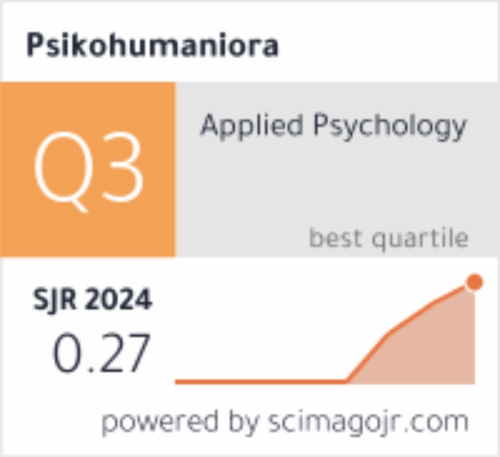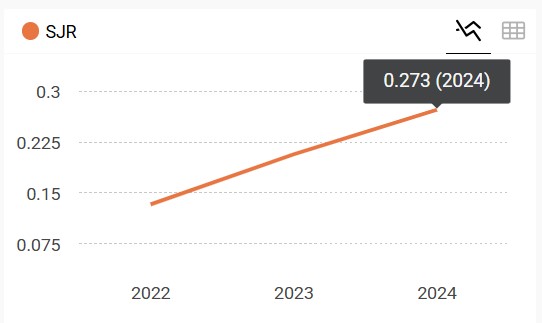Examining gender role attitude as a moderator of personality, social support, and childcare responsibilities in women’s work-life balance
DOI:
https://doi.org/10.21580/pjpp.v6i2.9591Keywords:
gender role attitudes, number of children, personality, social support, work-life balanceAbstract
The participation of women in the workforce creates challenges and problems. Those with various roles in their lives must be good at playing and balancing these successfully. This study focuses on the work-life balance factor by exploring the predictor factors including personality, family social support, and childcare responsibilities, as moderated by gender role attitude. A work/ nonwork interference and enhancement scale, mini-IPIP, gender role beliefs scale, and social support scale were developed for the data collection. A sample of 220 married female workers was identified using purposive sampling. The data analysis, which used multiple regression and a modgraph, shows a significant effect of personality, social support, and childcare responsibilities on the work-life balance moderated by gender role attitude. Four independent variables with significant influence are neuroticism, openness to experiencing family support, gender role attitude and there is a moderating effect on neuroticism and family support. The implication is the need to provide a comfortable work environment and arrangement of work patterns so that women's work-life balance can be achieved positively.
Downloads
References
Adachi, T. (2018). Work–family planning and gender role attitudes among youth. International Journal of Adolescence and Youth, 23(1), 52–60. https://doi.org/10.1080/02673843.2016.1269655
Atiq, S., Iqbal, S., & Rasheed, M. (2018). Work life balance and intention to quit among female workforce. Asia Pacific Journal of Advanced Business and Social Studies, 4(1), 117–126. https://doi.org/10.25275/apjabssv4i1bus12
Beauregard, T. A., & Henry, L. C. (2009). Making the link between work-life balance practices and organizational performance. Human Resource Management Review, 19(1), 9–22. https://doi.org/10.1016/j.hrmr.2008.09.001
Bell, A. S., Rajendran, D., & Theiler, S. (2012). Job stress, wellbeing, work-life balance and work-life conflict among Australian academics. E-Journal of Applied Psychology, 8(1), 25–37. https://doi.org/10.7790/ejap.v8i1.320
Blackstone, A. M. (2003). Gender roles and society. In R. M. Julia, M. L. Richard, & L. B. Schiamberg (Eds.), Human ecology: An encyclopedia of children, families, communities, and environments (pp. 335–338). ABC-CLIO.
Brown, M. J., & Gladstone, N. (2012). Development of a short version of the Gender Role Beliefs Scale. International Journal of Psychology and Behavioral Sciences, 2(5), 154–158. https://doi.org/10.5923/j.ijpbs.20120205.05
Bryant, R. M., & Constantine, M. G. (2006). Multiple role balance, job satisfaction, and life satisfaction in women school counselors. Professional School Counseling, 9(4), 265–271. https://doi.org/10.1177/2156759X0500900403
Costa, P. T., McCrae, R. R., & Kay, G. G. (1995). Persons, places, and personality: Career assessment using the revised NEO personality inventory. Journal of Career Assessment, 3(2), 123–139. https://doi.org/10.1177/106907279500300202
Crooker, K. J., Smith, F. L., & Tabak, F. (2002). Creating work-life balance: A model of pluralism across life domains. Human Resource Development Review, 1(4), 387–419. https://doi.org/10.1177/1534484302238434
Dilawati, R., Zulaiha, E., & Huraiani, Y. (2021). Perempuan dan ketahanan keluarga di masa pandemi COVID-19: Studi kasus mantan para pekerja perempuan di kota Bandung. Journal of Society and Development, 1(2), 46–58.
Dolan, P. (2008). Social support, social justice, and social capital: A tentative theoretical triad for community development. Community Development, 39(1), 112–119. https://doi.org/10.1080/15575330809489745
Donnellan, M. B., Oswald, F. L., Baird, B. M., & Lucas, R. E. (2006). The Mini-IPIP Scales: Tiny-yet-effective measures of the Big Five Factors of Personality. Psychological Assessment, 18(2), 192–203. https://doi.org/10.1037/1040-3590.18.2.192
Duxbury, L., & Higgins, C. (2018). Something’s got to give. University of Toronto Press.
Edralin, D. M. (2013). Work and life harmony: An exploratory case study of EntrePinays. DLSU Business and Economics Review, 22(2), 15–36.
Favero, L. W., & Heath, R. G. (2012). Generational perspectives in the workplace: Interpreting the discourses that constitute women’s struggle to balance work and life. Journal of Business Communication, 49(4), 332–356. https://doi.org/10.1177/0021943612456037
Fiori, K. L., Rauer, A. J., Birditt, K. S., Marini, C. M., Jager, J., Brown, E., & Orbuch, T. L. (2018). “I love you, not your friends”: Links between partners’ early disapproval of friends and divorce across 16 years. Journal of Social and Personal Relationships, 35(9), 1230–1250. https://doi.org/10.1177/0265407517707061
Fisher, G. G., Bulger, C. A., & Smith, C. S. (2009). Beyond work and family: A measure of work/nonwork interference and enhancement. Journal of Occupational Health Psychology, 14(4), 441–456. https://doi.org/10.1037/a0016737
Gora, R. (2016). Representasi perempuan dalam iklan televisi (Studi analisis semiotika iklan Beng Beng versi “Great Date”). Jurnal Semiotika, 10(1), 151–179. https://doi.org/10.30813/s:jk.v10i1.32
Greenhaus, J. H., Callanan, G. A., & DiRenzo, M. (2008). A boundaryless perspective on careers. In J. Barling & C. L. Cooper (Eds.), The SAGE handbook of organizational behavior (pp. 277–29). SAGE Publications Inc.
Gupta, S. (2016). A study on ‘Work Life Balance’ of married women employees teaching in technical institutions of Moradabad region. International Research Journal of Management Sociology & Humanities, 7(12), 82–89. https://doi.org/10.32804/IRJMSH
Haar, J. M., Roche, M., & Taylor, D. (2012). Work–family conflict and turnover intentions of indigenous employees: the importance of the whanau/family for Maori. The International Journal of Human Resource Management, 23(12), 2546–2560. https://doi.org/10.1080/09585192.2011.610344
Haar, J. M., Russo, M., Suñe, A., & Ollier-Malaterre, A. (2014). Outcomes of work–life balance on job satisfaction, life satisfaction and mental health: A study across seven cultures. Journal of Vocational Behavior, 85(3), 361–373. https://doi.org/10.1016/j.jvb.2014.08.010
House, J. S. (1981). Work stress and social support. Addison-Wesley Pub. Co.
ILO. (2016). Women at work: Trends. International Labour Office.
Kementerian Pemberdayaan Perempuan dan Anak. (2018). Statistik gender tematik: Profil generasi milenial Indonesia.
Krisberg, K. (2014). Anxiety: A normal response that can feel overwhelming. The Nation’s Health: A Publication of the American Public Health Association. https://www.thenationshealth.org/content/44/2/24
Kumara, J. W. N. T. N., & Fasana, S. F. (2018). Work life conflict and its impact on turnover intention of employees: The mediation role of job satisfaction. International Journal of Scientific and Research Publications (IJSRP), 8(4), 478–484. https://doi.org/10.29322/IJSRP.8.4.2018.p7666
Kundnani, N., & Mehta, P. (2014). Role of personality traits in balancing work-life. International Journal of Management Research & Review, 4(7), 722–731.
Kurniawan, T. (2021). Kontribusi pendapatan ibu rumah tangga pengolah buah aren (Arenga Pinnata) dan kontribusinya terhadap pendapatan keluarga (Studi kasus Desa Sei Limbat kecamatan Selesai Kabupaten Langkat). Universitas Muhammadiyah Sumatera Utara.
Kurpisz, J., Mak, M., Lew-Starowicz, M., Nowosielski, K., Bieńkowski, P., Kowalczyk, R., Misiak, B., Frydecka, D., & Samochowiec, J. (2016). Personality traits, gender roles and sexual behaviours of young adult males. Annals of General Psychiatry, 15, 28. https://doi.org/10.1186/s12991-016-0114-2
Lunau, T., Bambra, C., Eikemo, T. A., van der Wel, K. A., & Dragano, N. (2014). A balancing act? Work–life balance, health and well-being in European welfare states. European Journal of Public Health, 24(3), 422–427. https://doi.org/10.1093/eurpub/cku010
Marcinkus, W. C., Whelan‐Berry, K. S., & Gordon, J. R. (2007). The relationship of social support to the work‐family balance and work outcomes of midlife women. Women in Management Review, 22(2), 86–111. https://doi.org/10.1108/09649420710732060
Meenakshi, S. P., Subrahmanyam, V., & Ravichandran, K. (2013). The importance of work-life-balance. IOSR Journal of Business and Management, 14(3), 31–35.
Michalos, A. C. (Ed.). (2014). Encyclopedia of quality of life and well-being research. Springer Netherlands.
Moyer, J. D., & Hedden, S. (2020). Are we on the right path to achieve the sustainable development goals? World Development, 127, 104749. https://doi.org/10.1016/j.worlddev.2019.104749
Olivetti, C., Patacchini, E., & Zenou, Y. (2020). Mothers, peers, and gender-role identity. Journal of the European Economic Association, 18(1), 266–301. https://doi.org/10.1093/jeea/jvy050
Padma, S., & Reddy, M. S. (2013). Role of family support in balancing personal and work life of women employees. IJCEM International Journal of Computational Engineering & Management, 16(3), 2230–7893.
Pandey, V. K., Shukla, T., & Nanda, A. (2018). A study on impact of personality traits on work-life balance.
Rahmawati, A., Kusuma, A., & Sumardjijati, S. (2019). Perempuan dalam industri kreatif Indonesia. Jurnal Ilmu Komunikasi, 2(1). https://doi.org/10.33005/jkom.v0i1.30
Sari, E. K., & Zufar, B. N. (2021). Perempuan pencari nafkah selama pandemi COVID-19. Al-Mada: Jurnal Agama, Sosial, Dan Budaya, 4(1), 13–29. https://doi.org/10.31538/almada.v4i1.1106
Schieman, S., Glavin, P., & Milkie, M. A. (2009). When work interferes with life: Work-nonwork interference and the influence of work-related demands and resources. American Sociological Review, 74(6), 966–988. https://doi.org/10.1177/000312240907400606
Shaffer, M. A., Sebastian Reiche, B., Dimitrova, M., Lazarova, M., Chen, S., Westman, M., & Wurtz, O. (2016). Work and family-role adjustment of different types of global professionals: Scale development and validation. Journal of International Business Studies, 47(2), 113–139. https://doi.org/10.1057/jibs.2015.26
Shaleh, A. R. (2003). Pengaruh etos kerja dan locus of control terhadap sikap perempuan pada dirinya sebagai pekerja. Universitas Indonesia.
Shihab, N. (2019). Dari perempuan untuk perempuan: Catatan najwa. Youtube. https://www.youtube.com/watch?v=93FiM3tWT0g
Siregar, Y., Anogerajekti, N., & Attas, S. G. (2021). Markobar oral tradition as local wisdom of the Mandailing community. ICNCS Proceeding UNS.
Smith-Hefner, N. J. (2007). Javanese women and the veil in Post-Soeharto Indonesia. The Journal of Asian Studies, 66(2), 389–420. https://doi.org/10.1017/S0021911807000575
Smith-Hefner, N. J. (2019). Islamizing intimacies: Youth, sexuality, and gender in contemporary Indonesia. University of Hawaii Press.
Smith, J., & Gardner, D. (2007). Factors affecting employee use of work-life balance initiatives. New Zealand Journal of Psychology, 36(1), 3–12.
Swift, P., Cyhlarova, E., & Goldie, I. (2014). Living with anxiety: Understanding the role and impact of anxiety in our lives. Mental Health Foundation.
Thompson, C. A., & Prottas, D. J. (2006). Relationships among organizational family support, job autonomy, perceived control, and employee well-being. Journal of Occupational Health Psychology, 11(1), 100–118. https://doi.org/10.1037/1076-8998.10.4.100
Wahid, U., & Lancia, F. (2018). Exchange of public and domestic roles of men and women in Indonesian television soap opera “Dunia Terbalik” (Analysis of Social Discourse M. K. Halliday). Advanced Science Letters, 24(10), 7141–7146. https://doi.org/10.1166/asl.2018.12427
Watkins, A. (2015). Problematic identities in women’s fiction of the Sri Lankan diaspora. Brill Rodopi.
Wiasti, N. M. (2012). Redefinisi kecantikan dalam meningkatkan produktivitas kerja perempuan Bali, di Kota Denpasar. Piramida, 6(2), 1–22.
World Bank. (2021). Labor force participation rate, female (% of female population ages 15+) (modeled ILO estimate). The World Bank. https://data.worldbank.org/indicator/SL.TLF.CACT.FE.ZS
Yang, J. W., Suh, C., Lee, C. K., & Son, B. C. (2018). The work–life balance and psychosocial well-being of South Korean workers. Annals of Occupational and Environmental Medicine, 30(1), 38. https://doi.org/10.1186/s40557-018-0250-z
Zakaria, M. F., & Abdullah, A. H. (2018). The influence of big-five personality toward work- life balance : A teacher’s perspective. International Journal of Education, Psychology and Counseling, 3(8), 21–31.
Zimet, G. D., Dahlem, N. W., Zimet, S. G., & Farley, G. K. (1988). The multidimensional scale of perceived social support. Journal of Personality Assessment, 52(1), 30–41. https://doi.org/10.1207/s15327752jpa5201_2
Downloads
Published
How to Cite
Issue
Section
License
The copyright of the accepted article shall be assigned to the publisher of the journal. The intended copyright includes the right to publish the article in various forms (including reprints). The journal maintains the publishing rights to published articles.
In line with the license, authors and any users (readers and other researchers) are allowed to share and adapt the material only for non-commercial purposes. In addition, the material must be given appropriate credit, provided with a link to the license, and indicated if changes were made. If authors remix, transform, or build upon the material, authors must distribute their contributions under the same license as the original.



